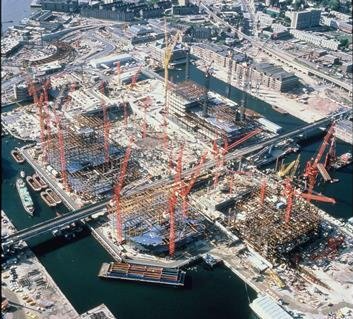1940s-1970s - Post-War Decline and Industrial Shift in East London East London’s Decline
After World War II: The End of an Era
After World War II, East London’s docks, particularly the area now known as Canary Wharf, began to lose their prominent role in global trade. Once the bustling heart of the city's economy, the docks were now in rapid decline, with crumbling warehouses and forgotten piers marking the loss of an iconic industrial area. For the people who had lived and worked there for generations, this period felt like the end of an era—one that had defined their identity and livelihoods.
The Shift in Global Trade and Industrial Decline
The cause of this decline wasn’t direct war damage, but rather the evolving global economy. The introduction of containerisation in the 1950s and 1960s revolutionized shipping. Large steel containers allowed for faster and more efficient transportation of goods across the globe. However, London’s aging docks, with their narrow infrastructure, could not accommodate the massive modern ships now dominating global trade routes.
As ports like Tilbury and Felixstowe adapted to the new shipping technology, London’s docks became obsolete. This industrial shift led to the economic decline of East London and the loss of thousands of jobs that had supported local families for generations.
Social and Economic Impact on East London Communities
The decline of the docks didn’t just affect the economy—it impacted the very fabric of the community. Families who had called the area home for decades found themselves without work. Streets that once thrived with dock workers and local businesses grew eerily quiet. The shops, pubs, and markets that had once been filled with the chatter of workers were now deserted.
For many residents, the docks were more than a workplace—they were a symbol of community and identity. Losing them felt like losing the heart of East London itself. The social fabric that had bound generations together was now unravelling, leaving many wondering what the future would hold.
The Struggles of the Working Class in East London
The personal toll of this economic change was deeply felt by the working class in East London. Imagine the frustration of a longshoreman who spent his entire career unloading ships, only to see his job disappear. Or the shopkeeper whose store, once bustling with dock workers, now stood empty and silent. These personal stories highlighted the painful economic transformation that was occurring.
As the industrial decline deepened, many began to feel that East London might never recover. By the 1970s, the area seemed beyond saving. However, the community’s resilience and the region’s potential for reinvention sparked the beginning of a new chapter in East London’s history.
The Regeneration of East London and the Rise of Canary Wharf
In the 1970s, plans for regenerating the docklands began to take shape. What seemed like a distant dream would eventually lead to one of the most dramatic urban transformations in London’s history. The redevelopment of the docklands marked the start of a new era for East London.
This transformation laid the groundwork for the birth of Canary Wharf, which is now one of the world’s most important financial hubs. The district, which was once synonymous with industrial decline, is now a symbol of economic revival and modern London.
From Decline to Renewal: A Lesson in Resilience
The story of East London’s industrial decline and regeneration is a testament to resilience and the ability to adapt. While the fall of the docks signaled the end of an era, it also sparked the transformation that would bring about the success of Canary Wharf. Today, Canary Wharf stands as a global financial centre, proving that even in times of loss and hardship, change can lead to something better.
Conclusion: The Transformation of East London
The industrial decline of East London’s docks didn’t just mark the end of an era—it set the stage for the area’s rebirth. This transformation from industrial decline to urban renewal shows that even in our darkest moments, there is the potential for remarkable change. The rise of Canary Wharf stands as a powerful reminder that with vision, resilience, and regeneration, even the most challenging economic shifts can lead to extraordinary growth.


